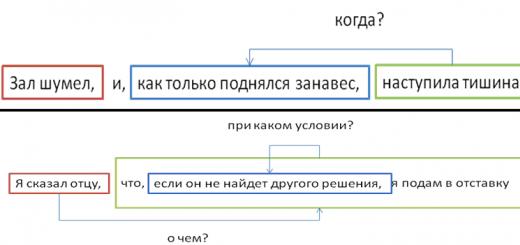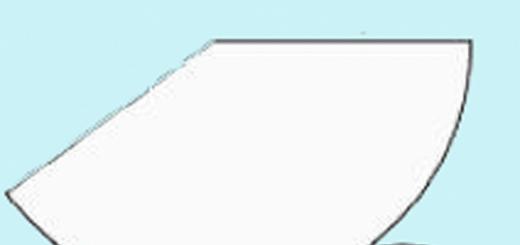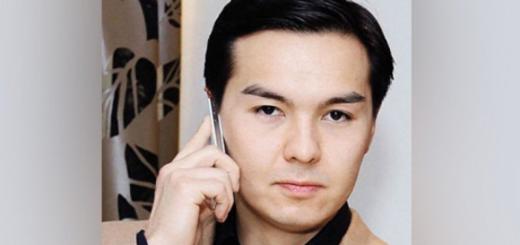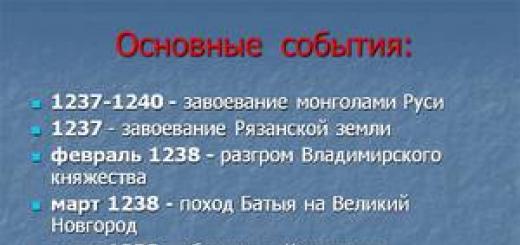Punctuation marks in complex sentences with conjunction and non-conjunction connections. Complex sentence with different types of connections.
Clue. Answers to the questions: what is a complex sentence and types of subordinate clauses can be found in tasks A24 and B6.
Rule.
The following algorithm will help you put punctuation marks in such sentences:
Trap!
If the subordinate clauses are homogeneous and there is a conjunction “I” between them, then before the second subordinate clause the repeated subordinating conjunction is skipped.
[This time I was already happy] , ( When the bell rang) And (Yurka burst into me).
It can be easily restored from context:
This time I was already happy when the bell rang and When Yurka barged into me).
This sentence follows the pattern: , () AND/OR ().
1. A comma at the junction of two conjunctions.
A comma at the junction of conjunctions can be used in two cases:
When between two stems connected by coordinating conjunctions, a subordinate clause is inserted, depending on the second stem.
With sequential subordination of subordinate clauses, when the second subordinate clause depends on the first, but at the same time requires a position in front of it.

Rule.
Algorithm of actions.
1. Highlight grammatical basics.
2. Identify conjunctions and determine whether they are coordinating or subordinating.
3. Determine the main and subordinate clauses (main - those from which the question is asked; subordinate - to which the question is asked).
4. Determine the boundaries of simple sentences that are part of a complex one (conjunctions are often indicate to the beginning of new grammatical basics!).
5. Add punctuation marks.
Analysis of the task.
Which answer option correctly indicates all the numbers that should be replaced by commas in the sentence?
Lucy was gently persistent (1) and (2) although it was difficult to remember everything (3) gradually the old woman told (4) how it was.
First, let's define the grammatical basics and highlight which of them are the main ones and which are the subordinate ones.
[Lucy was gently insistent] and [(although it was difficult to remember everything o) gradually the old woman told] (how it was).
Thus we get:
According to the rules, in a complex sentence with heterogeneous subordinate clauses, all grammatical bases must be separated from each other by commas.
BUT! In this sentence there is a junction of conjunctions AND ALTHOUGH. We read the proposal. In its second part there is no continuation of the conjunction THAT, SO, BUT, therefore a comma is placed between the conjunctions: AND, ALTHOUGH.
[Lucy was gently insistent], (1) and, (2) [(although it was difficult to remember everything o), (3) gradually the old woman told], (4) (how it happened).
The correct answer is option No. 2.
Practice.
1. Which answer option correctly indicates all the numbers that should be replaced by commas in the sentence?
It was getting dark (1) and (2) when we entered a sparse birch grove (3) the white trunks seemed to us like bright paper stripes stuck on the purple twilight.
1) 1, 2, 3 2) 2, 3 3) 3 4) 1, 2
2. Which answer option correctly indicates all the numbers that should be replaced by commas in the sentence?
At the fifteenth mile the rear tire burst (1) and (2) while he was repairing it on the edge of the ditch (3) the larks were ringing over the fields (4) as if they were worried about him.
1) 1, 3, 4 2) 1, 2, 3, 4 3) 2, 3 4) 1, 2, 4
3. Which answer option correctly indicates all the numbers that should be replaced by commas in the sentence?
Kurin suddenly remembered the desperate eyes and perky freckles of the girl instructor (1) and (2) despite the fact that in front of him now there was a boring gray road (3) and he had to walk a few more kilometers under the scorching sun (4) he suddenly felt cheerful.
At the beginning of the day, work is usually easy, easier than at the end, when thoughts are already confused. It’s the same at the beginning of a sentence: we skip through it easily, without stumbling over commas, let alone in the middle, when the devil himself can’t figure out the isolations and phrases. And we don’t stumble at the beginning of a sentence with commas because you rarely see them there.
About conjunctions with introductory words at the beginning of a sentence, a similar approach is to combining conjunctions. The rule is:
“At the beginning of a sentence, the coordinating and subordinating conjunctions, as well as the subordinating conjunction and the allied word, are not separated by a comma: Denis died. And when I was leaving, his old woman brought me a goose...(Priv.); Because where can they meet now?».
I would like to say “that’s all.” But no, not everything. This rule is from Lopatin’s reference book, and Rosenthal’s reference book is “more talkative”:
“The placement of a comma between the connecting conjunction (at the beginning of the sentence, after the period) and the subordinating conjunction that follows it depends on the meaning of the conjunction:
1) ...after the union And no comma is used: ; ;
2) after... union A no comma is used: ; ;
3) after the union But a comma is placed when there is a pause between conjunctions and is not placed if there is no pause (appreciate the deceit! - "According to the rules"): (Sim.); (Paul.);
4) after the union however A comma is usually used: ».
A comma at the beginning of a sentence after the conjunctions “but”, “however”, “and”, “a” before the subordinating conjunction
| A comma is placed | There is no comma | ||
| But(during a pause) | But, if the enemy then managed to repel the attackers, the infantry again rushed to the attack | But(no pause) | But when he, leaning on a stick, stepped out of the headquarters bus into the square... something pinched in the wound |
| However | However, if circumstances require it, I will not stand aside | AND | And although the weather has improved significantly, the danger of drought has not passed; And instead of turning right, we went straight by mistake |
| A | And when the sun rose, a view of the snowy peak opened before us; And if you believe weather forecasters, warming should come tomorrow |
||
TASK A26
Task formulation: which answer option contains all the numbers correctly?,
for a month
those whose sentences should have commas?
At first, no one could understand (1) how the boat went against the current without a sail and
motor (2) but (3) when the people went down to the river (4) everyone saw a team of dogs pulling the boat.
1) 1 , 2 2) 1,3 , 4 3) 1 , 2,3 , 4 4)2,4
Correct answer№ 3. You are not mistaken?
This task usually presents either a syntactic construction with a subordinating and coordinating connection, or a complex sentence with sequential subordination of subordinate clauses.
The above complex syntactic structure consists of four simple
proposals.
The first of these is the most important. An appendage is attached to it n oh explanatory note
help of a union word what
.
The third sentence is connected to the second using a coordinating conjunction But. The fourth is when d grinding part with time value and
prisko d moves to the third using temporary d repair union When.
What is required from students: knowledge of the topic: "Punctuation marks in a complex sentence with
union and non-union connection.
Complex sentence with different types of connections. Punctuation on
With like unions."
1. Punctuation Ia at the junction of alliances
Since this task often contains such a punctogram as a junction of conjunctions, let’s repeat the theory and remember the corresponding punctuation rule.
Joint with the union - This is the space in a sentence between two conjunctions:
· between two subordinating conjunctions;
· between coordinating and subordinating body union.
A comma is placed at the end of two conjunctions if the second conjunction does not have a continuation in the form of the words TO, BUT, etc.
The comma is not placed at the junction of two conjunctions, if the second conjunction continues not in
in the form of T words O, BUT, etc.
Compare two sentences:
1
.
Dmitry Sergeevich Likhachev wrote, what if you will have a respectful attitude.
To
others and a little resourcefulness,
will remember the rules of good behavior,
desire and
ability to apply them.
2. Dmitry Sergeevich Likhachev wrote, h
Toh if you will have there is no respect for
others and a little nah O readiness, That memory will come to the rules of good behavior, desire and
ability to apply them.
In these syntactic constructions there is a junction of conjunctions (two subordinating conjunctions are located nearby WHAT+IF).
In the first sentence of the second conjunction ESL And there is no continuation in the form of the word TO , therefore, at the junction of alliances we are one hundred vim for the fifth (WHAT, IF AND).
In the second sentence of the union E SL AND there is a continuation in the form of the word T O (IF... THO),
therefore at the junction with Union (WHAT IF) we do not add a comma.
2. Punctuation before the conjunction AND in a complex sentence
In task A 26 there is one more t rudnost: punctuation before the conjunction I.
Let’s compare two sentences and determine which of them has a comma before the conjunction AND,
and which one doesn’t (no punctuation marks):
·
The young writer looked carefully at the people around him (1) and (2) l And
noticed something interesting (3)
wrote down my observations (4) so that eat
used put them in your books.
·
The four of us were having dinner that day (1) and (2) when dessert was served (3) capri girl h -
but said (4) that cherry compo t tasteless.
In the first sentence, the conjunction AND connects homogeneous predicates(looked closely" And
“recorded”), so there is no comma in place of the number 1.
In place of the number 2 we will put
comma:
this is the junction of the conjunctions AND+IF, with the second conjunction IF there is no continuation in the form of words A
THAT . Commas are also placed in place of the numbers 3 and 4, as on the border of the main and subordinate parts.
So the correct answer is:
2
,
3,4
.
In in t in this sentence the conjunction I connects two simple sentences in a complex G O
(first grammatical stem: “we had dinner”,
second grammatical stem:
“the girl said”), so a comma is placed in place of the number 1. In place of the number 2 you should also put
comma: this is the junction of the conjunctions AND+WHEN, with the second conjunction WHEN there is no continuation in the form e words
THAT. There should also be commas in place of the numbers 3 and 4, as on the border of the main and subordinate clauses
parts.
So the correct answer is:
1, 2
,
3
,
4
.
To complete task A26, use the following algorithm:
1. Indicate the grammatical bases in the sentence.
2. Determine the boundaries of simple sentences as part of a complex syn. t axial construction.
3. Look, How are these sentences related? at home.
4. Find out whether the conjunction AND is present in the sentence, and if it is available in advance Please define what it connects:
· if the union And with ed removes homogeneous members, then there is no comma before it;
· if the conjunction AND connects simple sentences, then a comma is placed in front of it;
5. Install is there a junction of conjunctions in a complex syntactic construction, and in the case
determine its presence T e, is there a continuation with the second conjunction (through one simple transition? d position) in the form of words TO, BUT:
·
if the second conjunction does not have a continuation in the form of the words TO, BUT, etc.. , comma with t hangs out
at the junction of two unions;
· if the second conjunction has a continuation in the form of words THEN, BUT etc. A comma is not placed at the junction of two conjunctions.
6. Find the boundaries between the main and the d a t full-time and in their places put commas.
An example of using the algorithm when performing task A26:
Place punctuation marks in the following paragraph dposition:
The summer has passedGOGoh I graduated from college
atT(1
)
And(2)
when did I arrivelfrom PeTerburGA(3) pro-
WithI'd be amazedl(
4
)
how our
Gorod.
This is a complex sentence, consisting of from the main part“Last summer
Years I graduated from college and would be simply amazed l") and two subordinate clauses(“when did I arrive
Petersburg”, “how our city has changed”).
In this complex syntactic construction, there is a parallel d repairing
clauses suggested and go to the main thing.
Approximate time me is joined using the conjunction WHEN, A the explanatory clause is connected with the verb and in through the conjunction word HOW
Before the union I, in place of the number 1, a comma is not placed, since the conjunction And connects homogeneous members: “he graduated and was amazed.”
In place of the number 2, a comma is necessary: this is the junction of the conjunctions AND + WHEN,
at the second union
WHEN there is no continuation in the form of the word THEN.
In place of the numbers 2, 4, commas are placed as on the border of the main clause and the subordinate clause.
So the correct answer is: 2,3,4
1. When there are two adjacent subordinating conjunctions (or a subordinating conjunction and a conjunctive word), as well as when a coordinating conjunction and a subordinating (or conjunctive word) meet, a comma is placed between them, if the removal of the subordinate clause does not require restructuring of the main clause (practically - if no further follows the second part of the double conjunction then, yes, but, the presence of which requires such a restructuring), for example: The maid was an orphan who, in order to feed herself, had to go into service (L. Tolstoy) (the subordinate part to feed can be omitted or rearranged to another place in the sentence without restructuring the main part); Finally, he felt that he could no longer, that no force would move him from his place and that if he now sat down, he would no longer get up (B. Polevoy) (clause conditional with a conjunction if it can be omitted or rearranged); And the woman kept talking and talking about her misfortunes, and, although her words were familiar, Saburov’s heart suddenly ached from them (Simonov) (when removing the subordinate clause with the conjunction Although the prepositional-pronominal combination from them becomes unclear, but structurally such an exclusion is possible, therefore a comma is usually placed between the coordinating and subordinating conjunctions in such cases).
If the subordinate clause is followed by the second part of a double conjunction, then a comma is not placed between the previous two conjunctions, for example: The blind man knew that the sun was looking into the room and that if he extended his hand out the window, dew would fall from the bushes (Korolenko) (subordinate conditional with a conjunction if it cannot be omitted or rearranged without restructuring the subordinating sentence, since the words something and that will be nearby); The woman’s legs were burned and barefoot, and when she spoke, she scooped up warm dust with her hand to her inflamed feet, as if trying to soothe the pain (Simonov) (when removing or rearranging the subordinate tense with the conjunction when the words are nearby And And That).
Wed. also: A thunderstorm was approaching, and when clouds covered the entire sky, it became dark as at twilight. - A thunderstorm was approaching, and when the clouds covered the entire sky, it became dark, like twilight (in the second case, after the conjunction and, joining a complex sentence, a comma is not placed); The preparations dragged on, and when everything was ready to leave, there was no point in going (after the opposing union A in these cases, as a rule, a comma is not placed, since neither the removal nor the rearrangement of the subordinate clause following the conjunction is possible).
In sentences like “He left a long time ago, and where he is now, I don’t know,” a comma after the conjunction And not installed.
2. A comma is usually not placed between an connecting conjunction (after a period) and a subordinating conjunction, for example: And who you are, I know; Why this is being said, I don’t understand. The possibility of placing a comma after other connecting conjunctions is associated with the intonation-semantic highlighting of the subordinate clause, for example: However, if you so insist on your proposal, I am ready to accept it.










